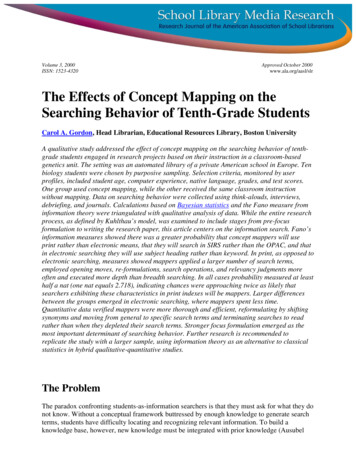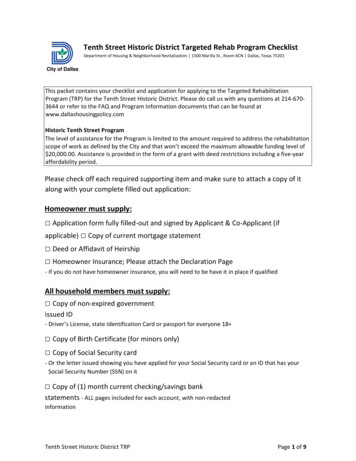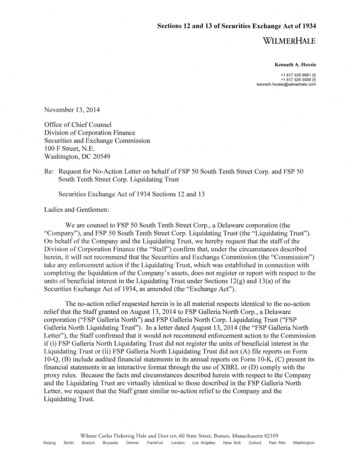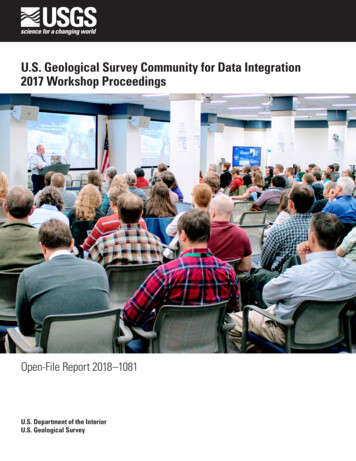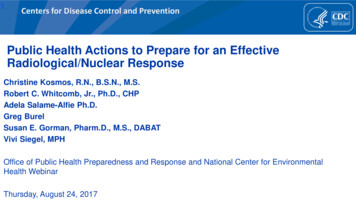
Transcription
EPTCS 180Proceedings of theTenth Workshop onModel Based TestingLondon, UK, 18th April 2015Edited by: Nikolay Pakulin, Alexander K. Petrenko and Bernd-HolgerSchlingloff
Published: 10th April 2015DOI: 10.4204/EPTCS.180ISSN: 2075-2180Open Publishing Association
Table of ContentsPreface . . . . . . . . . . . . . . . . . . . . . . . . . . . . . . . . . . . . . . . . . . . . . . . . . . . . . . . . . . . . . . . . . . . . . . . . . . . . . . . . . . . .1Using Model Checking to Generate Test Cases for Android Applications . . . . . . . . . . . . . . . . . . . . . . . .Ana Rosario Espada, María del Mar Gallardo, Alberto Salmerón and Pedro Merino7ioco theory for probabilistic automata . . . . . . . . . . . . . . . . . . . . . . . . . . . . . . . . . . . . . . . . . . . . . . . . . . . . . . . . 23Marcus Gerhold and Mariëlle StoelingaA Visual Formalism for Interacting Systems . . . . . . . . . . . . . . . . . . . . . . . . . . . . . . . . . . . . . . . . . . . . . . . . . . 41Paul C. JorgensenPotential Errors and Test Assessment in Software Product Line Engineering. . . . . . . . . . . . . . . . . . . . . . 57Hartmut Lackner and Martin SchmidtAdaptive Homing is in P . . . . . . . . . . . . . . . . . . . . . . . . . . . . . . . . . . . . . . . . . . . . . . . . . . . . . . . . . . . . . . . . . . . . 73Natalia Kushik and Nina Yevtushenko
PrefaceAlexander K. PetrenkoBernd-Holger SchlingloffNikolay PakulinISPRASMoscow, Russiapetrenko@ispras.ruHumboldt Universität zu BerlinBerlin, Germanyhs@informatik.hu-berlin.deISPRASMoscow, Russianpak@ispras.ruThis volume contains the proceedings of the 10th Workshop on Model-Based Testing (MBT 2015),held in London on April 18th , 2015, as a satellite workshop of the European Joint Conferences on Theoryand Practice of Software (ETAPS 2015). The first Workshop on Model-Based Testing in this series tookplace in 2004, in Barcelona.A tenth anniversary is a good opportunity to look back and to strike a balance, analyzing tendenciesof investigations in MBT for the last 10 years. This preface is not aimed at a thorough analysis; a flavorof the topics under consideration can be tasted by reviewing the invited papers made at the previous MBTworkshops. The list of speakers and titles of their talks was as follows:2004Keith StobieMicrosoft20042006Rober V. BinderHarry RobinsonmVerifyMicrosoft2006Alan HartmanIBM Haifa Research Labs2007Rob HieronsBrunel University2007Antti HuimaConformiq2008Wolfgang GrieskampMicrosoft2008Marie-Claude Gaudel2009Patrice GodefroidUniversité de Paris-Sud, OrsayMicrosoft2009Darko Marinov2010Jan Tretmans20122013Ina SchieferdeckerJan PeleskaUniversity of Illinois atUrbana-ChampaignRadboud University NijmegenFraunhofer FOKUSUniversity of Bremen,Verified Systems International GmbHA.K. Petrenko, B.-H. Schlingloff, N. Pakulin (Eds.):Tenth Workshop on Model-Based Testing (MBT 2015)EPTCS 180, 2015, pp. 1–6, doi:10.4204/EPTCS.180.0Model Based Testing in Practice atMicrosoftTest automationModel-based Testing for theMassesTen Years of Model Based Testing – A sober evaluationFinding a Good Order for Applying Adaptive Test CasesModel-Based Testing in the Standardization of Information andCommunication Technologies: theETSI PerspectiveUsing Model-Based Testing forQuality Assurance of ProtocolDocumentationCoverage-Based Random Exploration of Large ModelsWhitebox Fuzzing for SecurityTestingModel-Based Testing Using TestAbstractionsModel Based System DevelopmentModel-Based Security TestingIndustrial-Strength Model-BasedTesting – State of the Art and Current Challengesc A.K. Petrenko, B.-H. Schlingloff & N. Pakulin
2Preface2014Alexandre PetrenkoComputer Research Institute of MontrealHow Does Non-determinism Occur in Test Models and What DoWe Do with It?We would like to give a short retrospective on MBT beginning with a talk of Alan Harman, madein 2006, because of its notable title: Ten Years of Model Based Testing – A sober evaluation [6]. Thetitle of the talk claims that model-based testing has started at about 1996. In fact, MBT appeared alreadyin the 1970s, and, apparently, even earlier. The main MBT applications in those years were in the fieldof testing hardware logic and telecommunication protocols. The main modeling paradigms in this fieldwere Finite-State machine, Petri nets and other transition systems. The late 1990s is the period whenthe community understood that this approach can be effectively used not only for a rather narrow classof tasks close to telecommunication protocols, but also for practically all types of software, includingoperating systems, compilers, DBMS and others. This new approach to MBT immediately set the task toseek more adequate modeling paradigms for a new class of target systems. As the result the developersbegan to investigate requirement specification in the form of assertions or constraints and their specialcases for program contracts.A formal specification of requirements can be treated as a model of the behavior of a system undertest. The testing task can be considered as the task of generating tests which properly cover the requirements model, with a subsequent “translation” of these “model tests” to the platform of “implementation”or “target tests”.Apparently, this new trend of MBT applications was reflected in articles such as T. J. Ostrand andM. J. Balcer’s The Category-Partition Method for Specifying and Generating Functional Tests [7]. Thismethod later became known as CPM. The essence of the CPM method is to design tests on the basis ofa certain state machine, the states of which correspond to the domains of input space, i.e., partitions.Those input space domains, in turn, correspond to the data domains where predicates making up theassertions of functional specification of the system under test operations take true or false values – that is,the input space is divided into partitions according to the terms described in specifications of functionalrequirements to operations under test.Ostrand and Balcer offered a certain method of projecting tests. However, nothing was said aboutthe tools supporting those methods. Probably, one of the first works aimed at designing a tool kit tosupport the method was the KVEST technology (I. Burdonov, A. Kossatchev, A.K.Petrenko, D. Galter KVEST: Automated Generation of Test Suites from Formal Specifications [3]) and the followingUniTESK technology (I. Bourdonov, A. Kossatchev, V. Kuliamin, and A.K. Petrenko. UniTesK TestSuite Architecture [2]). Both technologies were based on the experience of the development testingmethodology within the frames of Space Shuttle “Buran” designed in the late 1980s (A.K. Petrenko.Test specification based on trace description [8]).This stage of MBT development was advanced with the emergence of test generation based on abstract state machines (W. Grieskamp, Y. Gurevich, W. Schulte, and M. Veanes. Conformance Testingwith Abstract State Machines [4]), followed by SpecExplorer (A. Blass, Y. Gurevich, L. Nachmanson,and M. Veanes. Play to test [1]) in 2005.Actually, the idea of organizing an MBT workshop appeared after one of the authors of this Prefacemet Yury Gurevich in Novosibirsk at Ershov Conference PSI-2001. Both future organizers of the MBTworkshop aimed at designing technologies for testing of system software (including operating systems).The group of A.K. Petrenko has been developing the testing approach on the basis of behavioral modelsin the form of program contracts. The group headed by Yury Gurevich used ASMs as the main modeling
A.K. Petrenko, B.-H. Schlingloff & N. Pakulin3technique. After some time it became clear that the techniques of explicit (executable) and implicit (inthe form of constraints) specifications are complementary to each other. As a result, the contemporarytools UniTESK and Microsoft Spec Explorer use both model types.At the end of 2002, the idea appeared to organize MBT workshop as a satellite event of ETAPS-2004,and devote it to testing on the basis of formal models – the idea that was gaining more and more supporters that time. We decided not to restrict it to only a certain narrow class of models or test generationtechniques. Thus, from the very first workshops there were supporters of many different variations ofMBT.The list of the invited talks, presented above, shows, on the one hand, the rather a wide range of workthat has been carried out in the field of MBT and, on the other hand, suggests some reflections.In particular, it is interesting to note that in the beginning of the list, practitioners prevailed, whiletowards the end of the list theoreticians dominate. Why so? We could imagine a number of potentialreasons:a. Firstly, when this new theme was developing, practitioners were invited to show convincing usecases of MBT in large-scale industrial projects.b. Secondly, it seems that in recent years practical MBT tools reached their limit in utilizing existingtechniques: by now the tools have implemented most of what can be achieved at the present technological level. However, the development does not end here; we face a period of accumulatingnew knowledge that will make new fundamental advances in practical MBT development possible.Therefore, in recent years interest has shifted towards more theoretical research questions.And one more observation: we can see an obvious predominance of giants such as Microsoft, IBM,Nokia among practitioners (Conformiq is mainly oriented towards Nokia’s demands). This can probablybe explained by the fact that development of an industrial-strength MBT tool and MBT applicationsrequires significant resources, which are hardly available for small and medium-sized companies.Observing the list of invited speakers (or, more generally, the list of all the speakers at recent MBTworkshops), there is no prevailing trend in the modeling paradigms or testing techniques employed. Onthe basis of this observation we propose that different approaches to MBT are, on the one hand, complementary, and, on the other hand, the approaches need both methodological integration and unification onthe level of testing system components and unified interfaces.This allows us to implement shared use of model analyzers and program source codes, data generators, provers, systems for collecting and run-time monitoring, etc.Let us briefly reflect on the perspectives of MBT: Though no revolutionary ideas in MBT development have been proposed in recent years, there aremany problems for which the development of methods and underlying theories is required. There are challenging technical and engineering problems in the development of tools for MBT;still there are no MBT-specific solutions, as construction of MBT tools is based on a wide rangeof software engineering technologies (including both traditional means and more recent ones likeprovers and solvers). A current trend in developing MBT tools is its integration with a variety ofapproaches – static and static-dynamic analysis of programs, as well as software model checkingtechnologies. There are some fundamental challenges in MBT deployment:– The first difficulty (not the main one) is related to teaching new methods of testing for testers.This requires not only ”training”, but education of the tester, who also has to be an expert in
4Prefacerequirements analysis, their modeling and “translation” of high-level requirements presentedto the level of implementation under test interfaces.– The second problem is the issue of how to obtain “good” models. It is both technical (in whatform models should be designed) and organizational (how to build a joint process of implementation design and model design). The experience shows that skilled software designersdon’t want to duplicate their work and waste time on designing a model, besides the implementation itself; and unskilled programmers can do well neither in coding nor in behaviormodeling. MBT deployment requires substantial resources, however there are no fundamental difficulties ifthe organization decides to introduce MBT in practice. A good example to this is the experienceof Microsoft lab in China (see for instance W. Grieskamp, Xiao Qu, Xiangjun Wei, N. Kicillof, M.B. Cohen. Interaction Coverage meets Path Coverage by SMT Constraint Solving [5]). MBT is actively used in the fields having the experience of systematic certification of softwaresystems, particularly in avionics and automotive. Since this domain is becoming more and moreimportant, a challenge is to align MBT with certification processes and regulations.This year’s MBT workshop features Ana Cavalli from Institut National des Telecommunications,Paris, France as invited speaker. In her speech, entitled “Evolution of testing techniques: from activetesting to monitoring techniques”, she presents the evolution of these testing techniques, their advantagesand limitations, and illustrates the application of monitoring techniques to the security testing of real casestudies.The contributions selected by the Program Committee reflect both applications of MBT in industrialpractice and further development of MBT theory and techniques.Ana Rosario Espada, Maria Del Mar Gallardo, Alberto Salmerón and Pedro Merino present an approach to automated model construction and test generation for Android mobile applications. MarcusGerhold and Mariëlle Stoelinga extend the well-known notion of input-output conformance to probabilistic state machines, opening the door to development of new classes of models and test constructiontechniques. Paul Jorgensen presents a novel variation of Petri-nets to facilitate visual modeling of interacting components in complex systems. Hartmut Lackner and Martin Schmidt discuss quality of testsuites for product lines and develop an assessment approach based on mutation operators applied to software product lines. Natalia Kushik and Nina Yevtushenko present new result in the theory of FSM; theyshow that for some FSMs its homing sequence can be built in polynomial time.The workshop is concluded by a remotely presented talk by Yury Gurevich on “Testing Philosophy”.We would like to thank the program committee members and all reviewers for their work in evaluating the submissions for the whole period of MBT workshops. We also thank the ETAPS organizersfor their assistance in preparing the workshops and the editors of EPTCS for help in publishing theseworkshop proceedings.Alexander K. Petrenko,Holger Schlingloff,Nikolay PakulinMarch 2015References[1] Andreas Blass, Yuri Gurevich, Lev Nachmanson & Margus Veanes (2005): Play to test. Technical ReportMSR-TR-2005-04, Microsoft Research. Available at http://research.microsoft.com/apps/pubs/
A.K. Petrenko, B.-H. Schlingloff & N. Pakulin5default.aspx?id 70129. A short version appears in: FATES 2005, LNCS vol. 3997, pp. 32-46.[2] Igor B. Bourdonov, Alexander Kossatchev, Victor V. Kuliamin & Alexander K. Petrenko (2002): UniTesKTest Suite Architecture. In: FME 2002: Formal Methods - Getting IT Right, International Symposium ofFormal Methods Europe, Copenhagen, Denmark, July 22-24, 2002, Proceedings, pp. 77–88, doi:10.1007/3540-45614-7 5.[3] Igor B. Burdonov, Alexander Kossatchev, Alexandre K. Petrenko & Dmitri Galter (1999): KVEST: AutomatedGeneration of Test Suites from Formal Specifications. In: FM’99 - Formal Methods, World Congress on FormalMethods in the Development of Computing Systems, Toulouse, France, September 20-24, 1999, Proceedings,Volume I, pp. 608–621, doi:10.1007/3-540-48119-2 34.[4] Wolfgang Grieskamp, Yuri Gurevich, Wolfram Schulte & Margus Veanes (2001): Conformance Testing withAbstract State Machines. In R. Moreno-Diaz & A. Quesada-Arencibia, editors: Formal Methods and Tools forComputer Science; Proceedings of Eurocast 2001. Available at px?id 77832.[5] Wolfgang Grieskamp, Xiao Qu, Xiangjun Wei, Nicolas Kicillof & Myra B. Cohen (2009): Interaction Coverage Meets Path Coverage by SMT Constraint Solving. In: Testing of Software and Communication Systems,21st IFIP WG 6.1 International Conference, TESTCOM 2009 and 9th International Workshop, FATES 2009,Eindhoven, The Netherlands, November 2-4, 2009. Proceedings, pp. 97–112, doi:10.1007/978-3-642-050312 7.[6] Alan Hartman (2006): Ten Years of Model Based Testing – A sober evaluation. Available at delBasedTestingSoberEvaluation.PDF. Invited talk atthe Second Workshop on Model Based Testing March 25-26, 2006 Vienna , Austria.[7] Thomas J. Ostrand & Marc J. Balcer (1988): The Category-Partition Method for Specifying and GeneratingFunctional Tests. Commun. ACM 31(6), pp. 676–686, doi:10.1145/62959.62964.[8] Alexander K. Petrenko (1993): Test Specfication Based on Trace Description. Programming and ComputerSoftware 19(1).
6PrefaceProgram committee Bernhard Aichernig (Graz University of Technology, Austria) Jonathan Bowen (Birmingham City University, Worshipful Company of Information Technologists, UK) Mirko Conrad (samoconsult GmbH, TU Mnchen, Humboldt University of Berlin, Germany) John Derrick (University of Sheffield, UK) Bernd Finkbeiner (Universitat des Saarlandes, Germany) Lars Frantzen (Radboud University Nijmegen , Netherlands) Ziyad Hanna (Jasper Design Automation, USA) Philipp Helle (EADS, Germany) Mika Katara (Tampere University of Technology, Finland) Alexander S. Kossatchev (ISP RAS, Russia) Victor Kulaimin (ISP RAS, Russia) Bruno Legeard (Smartesting, France) Bruno Marre (CEA LIST, France) Laurent Mounier (VERIMAG, France) Nikolay Pakulin (ISP RAS, Russia) Jan Peleska (University of Bremen, Germany) Alexander K. Petrenko (ISP RAS, Russia) Alexandre Petrenko (Computer Research Institute of Montreal, Canada) Fabien Peureux (University of Franche-Comte, France) Holger Schlingloff (Fraungofer FIRST, Germany) Julien Schmaltz (Open University of The Netherlands, Netherlands) Nikolai Tillmann (Microsoft Research, USA) Stephan Weissleder (Fraunhofer FOKUS, Germany ) Nina Yevtushenko (Tomsk State University, Russia)
Using Model Checking to Generate Test Cases for AndroidApplicationsAna Rosario EspadaMarı́a del Mar GallardoAlberto SalmerónPedro MerinoDept. Lenguajes y Ciencias de la ComputaciónE.T.S.I. Informática University of Málaga [anarosario,gallardo,salmeron,pedro]@lcc.uma.esThe behavior of mobile devices is highly non deterministic and barely predictable due to the interaction of the user with its applications. In consequence, analyzing the correctness of applicationsrunning on a smartphone involves dealing with the complexity of its environment. In this paper,we propose the use of model-based testing to describe the potential behaviors of users interactingwith mobile applications. These behaviors are modeled by composing specially-designed state machines. These composed state machines can be exhaustively explored using a model checking toolto automatically generate all possible user interactions. Each generated trace model checker can beinterpreted as a test case to drive a runtime analysis of actual applications. We have implemented atool that follows the proposed methodology to analyze ANDROID devices using the model checkerSPIN as the exhaustive generator of test cases.1IntroductionAt present, smartphone technology is ubiquitous and changes constantly. Users use their mobiles not onlyas phones, but as compact computers, able to concurrently provide services which are rapidly created,updated, renewed and distributed. In this scenario of continuous evolution, different operating systemshave been developed such as SYMBIAM , IOS , WINDOWS PHONE and ANDROID, which allow phones tosupport more and more complex applications. These platforms define new models of execution, quitedifferent from those used by non-mobile devices. For instance, one of the most defining characteristicsof these systems is their open and event-driven nature. Mobile devices execute a continuous cycle thatconsists of first, waiting for the user input and second, producing a response according to that input. Inaddition, the internal structure of mobile systems is constructed from a complex combination of applications, which enable users to easily navigate through them. Thus, although, at a lower level, the executionof applications on a mobile device involves the concurrent execution of several processes (for instance,in ANDROID, applications are JAVA processes executing on the underlying LINUX operating system), theway these applications interact with each other and with the environment does not correspond with thestandard interleaving based concurrency model.It is clear that the execution of applications on these new operating systems, such as ANDROID [1],may lead to the appearance of undesirable bugs which may cause the phone to malfunction. For example,mobile devices may display the typical errors of concurrent systems such as violations of safety andliveness properties. However, there are other bugs inherent to the particular concurrency model supportedby the new platforms which are not directly analyzable using current verification technologies. For Workpartially supported by grants P11-TIC-07659 (Regional Government of Andalusia), TIN2012-35669 (Spanish Ministry of Economy and Competitiveness), UMA-Agilent Technologies 808/47.3868- 4Green and the AUIP as sponsor of theScholarship Program Academic Mobility.A.K. Petrenko, B.-H. Schlingloff, N. Pakulin (Eds.):Tenth Workshop on Model-Based Testing (MBT 2015)EPTCS 180, 2015, pp. 7–21, doi:10.4204/EPTCS.180.1c Espada, Gallardo, Salmerón & Merino
8Using Model Checking to Generate Test Cases for Android Applicationsexample, applications could incorrectly implement the life cycles of their activities or services (in the caseof ANDROID), or may misbehave upon the arrival of unexpected external events. In addition, conversionerrors, unhandled exceptions, errors of incompatibility API and I / O interaction errors as described in [16]may also appear.Different techniques for analyzing the execution of mobile platforms have been proposed. Verification approaches such as model checking [9] can be applied to the software for mobile devices[22, 21, 19]. Model checking is based on a exhaustive generation of all the inter leavings for the threads/processes. A major problem to apply this technique to the real code, like mobile applications, it theneed to construct a model of the underlaying operating system or libraries [10, 7, 11]. The open nature ofthese platforms, which are continuously interacting with an unspecified environment, makes other analysis techniques such as testing, monitoring, and runtime verification more suitable to check bugs withouttoo much extra effort to model the operating system or the libraries. There have been several recentproposals [12, 24, 18] for testing in this framework with commercial tools [4, 2]. In these approaches,test cases are randomly generated with tools such as M ONKEY and M ONKEY RUNNER [1].Testing and runtime verification maybe also combined, as described in [6], to construct verificationtools for mobile applications [20, 26]. On the one hand, the careful selection of test cases guides the execution of the device, while, on the other, the runtime verification module implements observers devotedto analyzing the traces produced by the device. The runtime verification module was already addressedby some authors of this paper in [14]. Here we focus on describing how the generation of test cases maybe carried out following the model-based testing approach [25] supported by model checking tools.Our proposal is based on the idea that although the interaction between the user and the mobiledevice is completely undetermined, each application is associated with a set of intended user behaviorswhich define the common ways of using the application. For each application, or more precisely, for eachapplication view, we use state machines to construct a non deterministic model representing the expecteduse of the view/application. This state machine is built semiautomatically, with information provided bythe expert (the app designer or tester) and by ANDROID supporting tools like UI AUTOMATORV IEWER.Then, all these view models may be conveniently composed to construct a non deterministic model ofthe user interaction with a subset of mobile applications of interest. Due to the way of building the statemachines, each execution trace of the composed state machine corresponds to a possible realistic use ofthe mobile. Thus, the generation of test cases is reduced to the generation of all possible behaviors ofthe composed machine, which may be carried out by a model checking tool. Although the methodologyproposed does not depend on the underlying mobile operating system, the tool has been built on theassumption that the operating system is ANDROID.The paper provides two main contributions. The first one is the formal definition of a special typeof state machine that models the expected user interaction with the mobile application. The approachto modeling is completely modular in the sense that adding (or removing) new view state machines toincorporate (eliminate) user behaviors does not affect the rest of state machines that have already beendefined. The second one is a method to employ the explicit model checker SPIN [15] that takes thecomposed state machine as input and and produces a significant set of test cases that generate traces forruntime verification tools. We have constructed a tool chain which implements both modeling and testgeneration phases to shows the feasibility of the approach in practice.The rest of the paper is organized as follows. Section 2 describes our approach to using modelchecking for test case generation. Section 3 introduces the testing platform that we are developing.Section 4 provides a formal description of the behaviour of composed state machines. Section 5 useswell known ANDROID applications to describe how our approach for test case generation is implemented.Section 6 gives a comparison with related work. Last section summarizes conclusions and future work.
Espada, Gallardo, Salmerón & Merino12345678910111213141516171819202122239mtype { state init , state 1 , state 2 };typedef Device { byte transitions [ MAX TR ]; short index ; bool finish ; }Device devices [ DEVICES ];mtype state [ DEVICES ];active proctype traceCloser () provided ( devices [ DEVA ]. finish && devices [ DEVB ]. finish ) {end tc : o ut p u t T r a n s i t i o n s ()}active proctype device A () {state [ DEVA ] state init ;do:: state [ DEVA ] state init - transition ( DEVA , BUTTON 1 ) ; state [ DEVA ] state 1:: state [ DEVA ] state 1 - transition ( DEVA , SWIPE ) ; state [ DEVA ] state 1:: state [ DEVA ] state 1 - transition ( DEVA , BUTTON 2 ) ; state [ DEVA ] state 2:: state [ DEVA ] state 2 - transition ( DEVA , MESSAGE ) ; break:: state [ DEVA ] state 2 - transition ( DEVA , BACK ) ; breakod ;devices [ DEVA ]. finish true ;}active proctype device B () {state [ DEVB ] state init ;.devices [ DEVB ]. finish true ;}Listing 1: Sample PROMELA specification for test generation2Model checking for test case generationSPIN [15] is a model checker that can be used to verify the correctness of concurrent software systemsmodeled using the specification language PROMELA. The focus of the tool is on the design and validationof computer protocols, although it has been applied to other areas. SPIN can check the occurrence ofa property over all possible executions of a system specification, and provide counterexamples whenviolations are found.We use the SPIN model checker in our approach for automatically generating test cases from application models in the following way. First, each device will be represented by a single PROMELA process,which contains a state machine that models the applications contained on that device. The state machinesthemselves are written as loops, where each branch corresponds to a transition triggered by an event. Thecurrent state of each state machine (stored as a global PROMELA variable) determines which branchesare active and may be taken. The right hand side of each branch records the transition and updates thecurrent state. This PROMELA specification is explored exhaustively by SPIN in order to generate all possible test cases described by the application model, taking all possible alternatives when there is morethan one active branch at the same time.Listing 1 shows an example of a PROMELA specification that follows the approach outlined above.This example contains two devices and with their corresponding state machine (device A() in line 8and device B() in line 19), with two states plus the initial state. The transition function is used torecord the user or system transition associated with each branch. In order to complete a test case, alldevices must have finished their respective state machines (lines 17 and 22), usually when the do loop isexited (lines 14 and 15). This enables the traceCloser process to be executed due to its schedulabilityrestrictions (line 5), which prints the transitions of the generated test case.In addition to the current state (line 4), this PROMELA specification also keeps a list of the transitionstaken on the test currently being generated (line 2). The purpose of this data structure is twofold. On theone hand, outputTransitions will print the trace stored here. On the other hand, the history of the
10Using Model Checking to Generate Test Cases for Android ApplicationsFigure 1: Architecturecurrent trace is kept inside the SPIN’s global state, which is taken into consideration when deciding if astate has already been visited. Thus, the same transition may be taken more than once if possible (e.g.line 12), since the history of the states will be different. However, this requires the maximum depth ofexploration to be bounded by the MAX TR constant (line 2).3Architecture of
EPTCS 180 Proceedings of the Tenth Workshop on Model Based Testing London, UK, 18th April 2015





